Blank Forms @NY

Khaki green bowl with lizard
φ: 8 5/8″
H: 4″
Clay from Kagawa prefecture, grapevine ash, feldspar
In Japan, dead bodies are incinerated. Since human beings are made from the elements, there is no problem in resurrecting them if they are reduced to the elements-but we do not have to become zombies. I once worked on a series called “Cremation Bowls.” The pieces were made to order, the idea being that they might eventually join their owners in the incinerator. When a deceased person’s beloved tea bowl is set in a coffin and fired, its color is changed by the illumination of the alkaline earth metal. This is why firing is closely related to funerals in Japan. The calcium-derived white, which is a remnant of a dead lizard, reminds me of the shadow of a person stuck to the stairs after the atomic bombing, or the sacred scar worshipped by Catholics. I’ve done bowls with centipedes before, and they melt better than lizards. Anyway, The Human Centipede was a terrible movie.

left
Small plate, smallest out of the three
φ: 3 3/8“
Porcelain
In Japan, when you go to a bar, you are served a snack called otoshi. A bar commissioned me to this for that purpose.
right
Small plate
φ: 5″
Porcelain
This is made to feel like an earlobe when you pinch it.
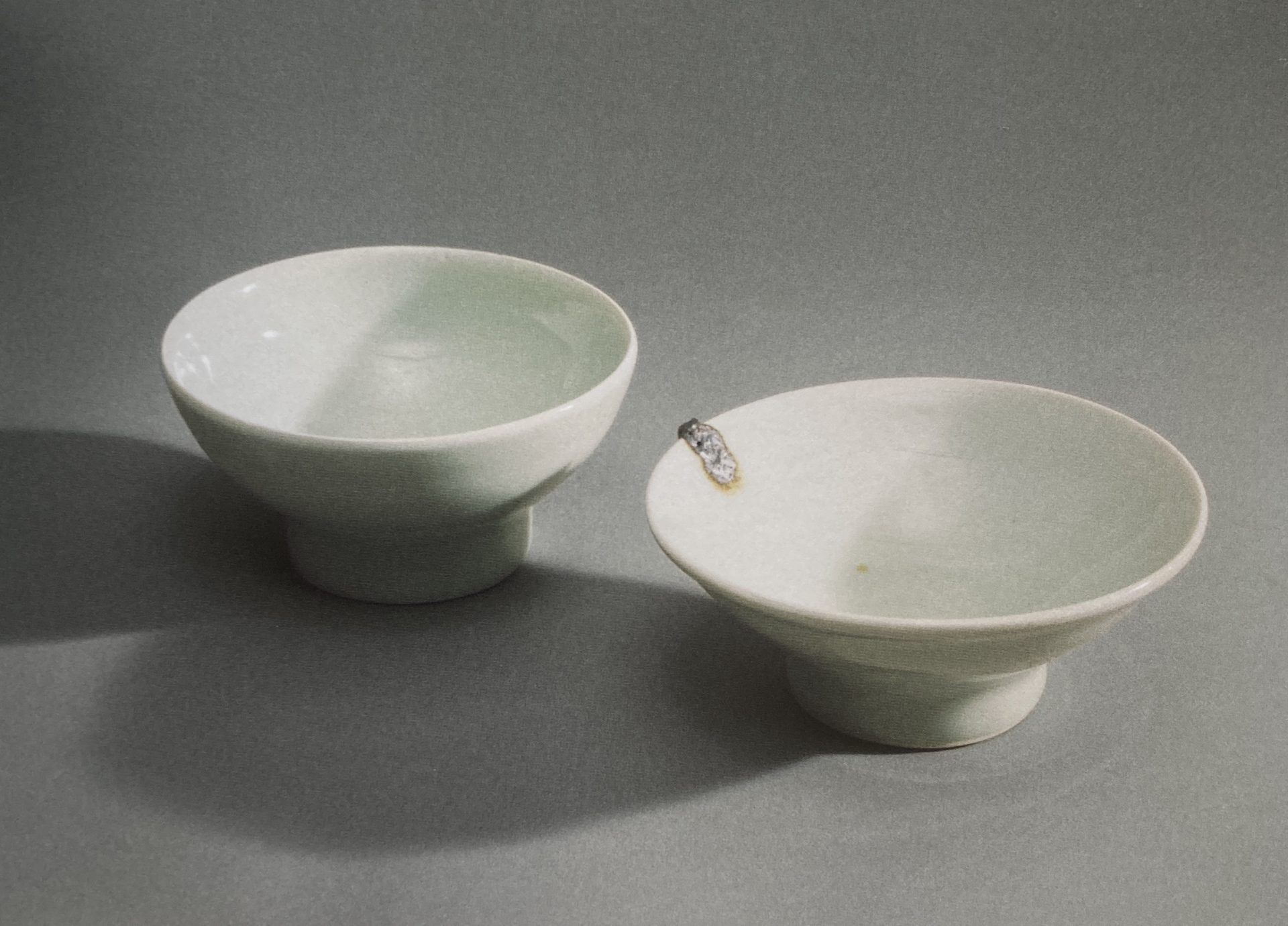
left
Bowl,small
φ: 4 1/2″
H: 2 1/2″
Porcelain
White porcelain was first created by accident in ancient China; then the emperor ordered the potter to replicate it. But after a series of failures, the potter committed suicide by throwing himself into the kiln, as potters often do. When the kiln was opened, they found that a beautiful white porcelain had been produced. So they started to throw slaves into the kiln. When they ran out of slaves, they turned to pigs. Eventually, they realized that smoke was the important element, and finally established reduction firing. It took another 1,700 years or so for Japan to catch up in white porcelain production.
right
Bowl with repaired rift
φ: 5 1/8″
H: 2 1/8″
Porcelain, weathered basalt

Plate, medium
φ: 9 1/4″
Porcelain
One in a series of plates of similar dimensions made to order.

left
Plate, medium
φ: 9 1/4″
Porcelain
One in a series of plates of similar dimensions
made to order.
right
Plate, small
φ: 7 1/8″
Porcelain

Irregular bowl painted with light purple glaze
φ: 5 3/4″ / 5 I/2″
H: 3″
Garden clay

Small plate with Epiophlebia superstes drawing
φ: 5″
Porcelain
When wheel throwing my series of thick-rimmed, hemoglobin-shaped plates, I use a spatula on the inside, which creates an umbilical protrusion. Using this method, I once made and exhibited a number of pieces with needle-like bumps in the middle. This, however, is a relatively quiet piece.

Small bowl with rough glaze details
φ: 5″
H: 2 3/8″
Porcelain
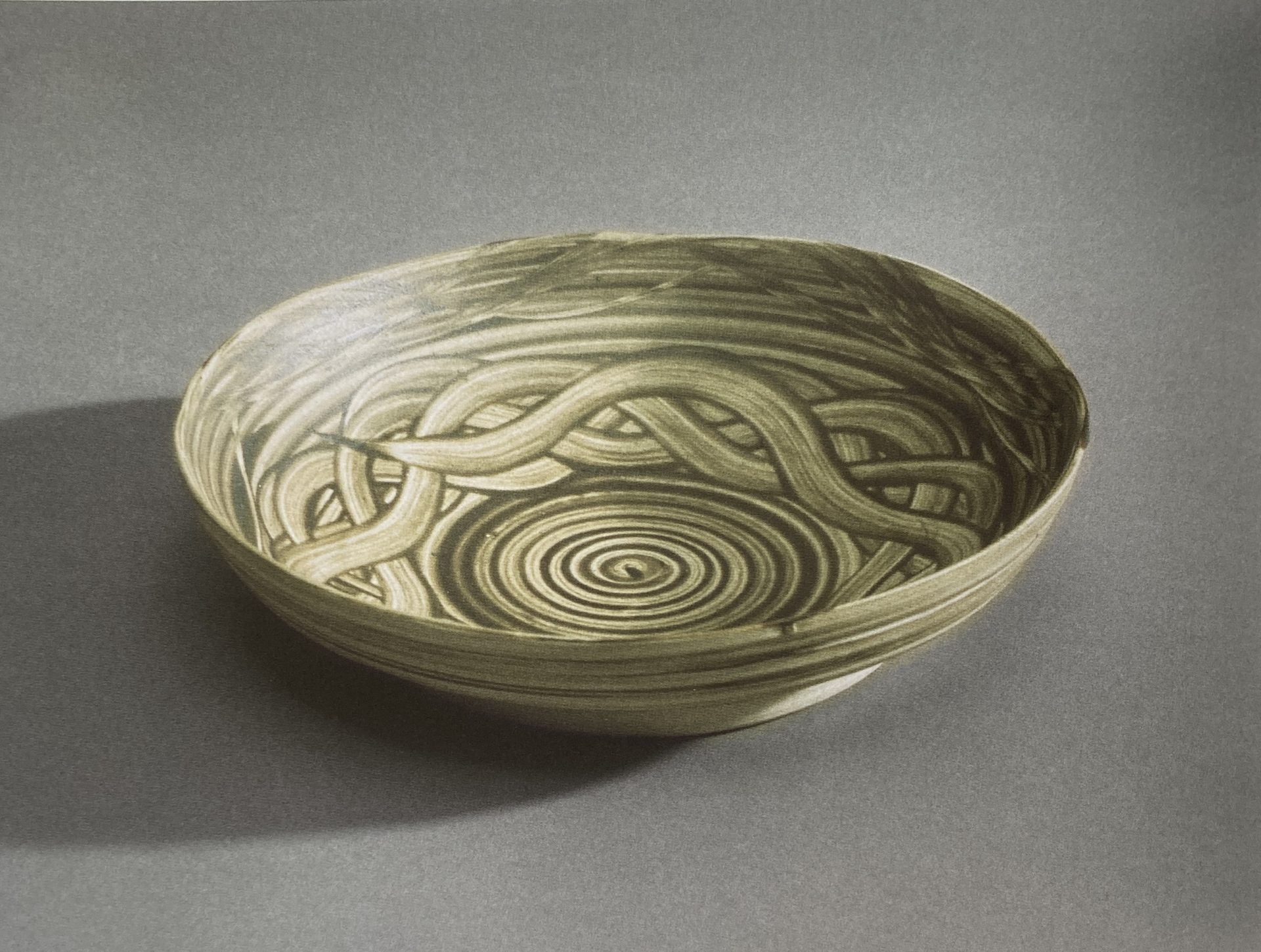
Plate with spiral patterns, matte finish
φ:7
Porcelain, cobalt
Drawn with fingers while turning the potter’s wheel.
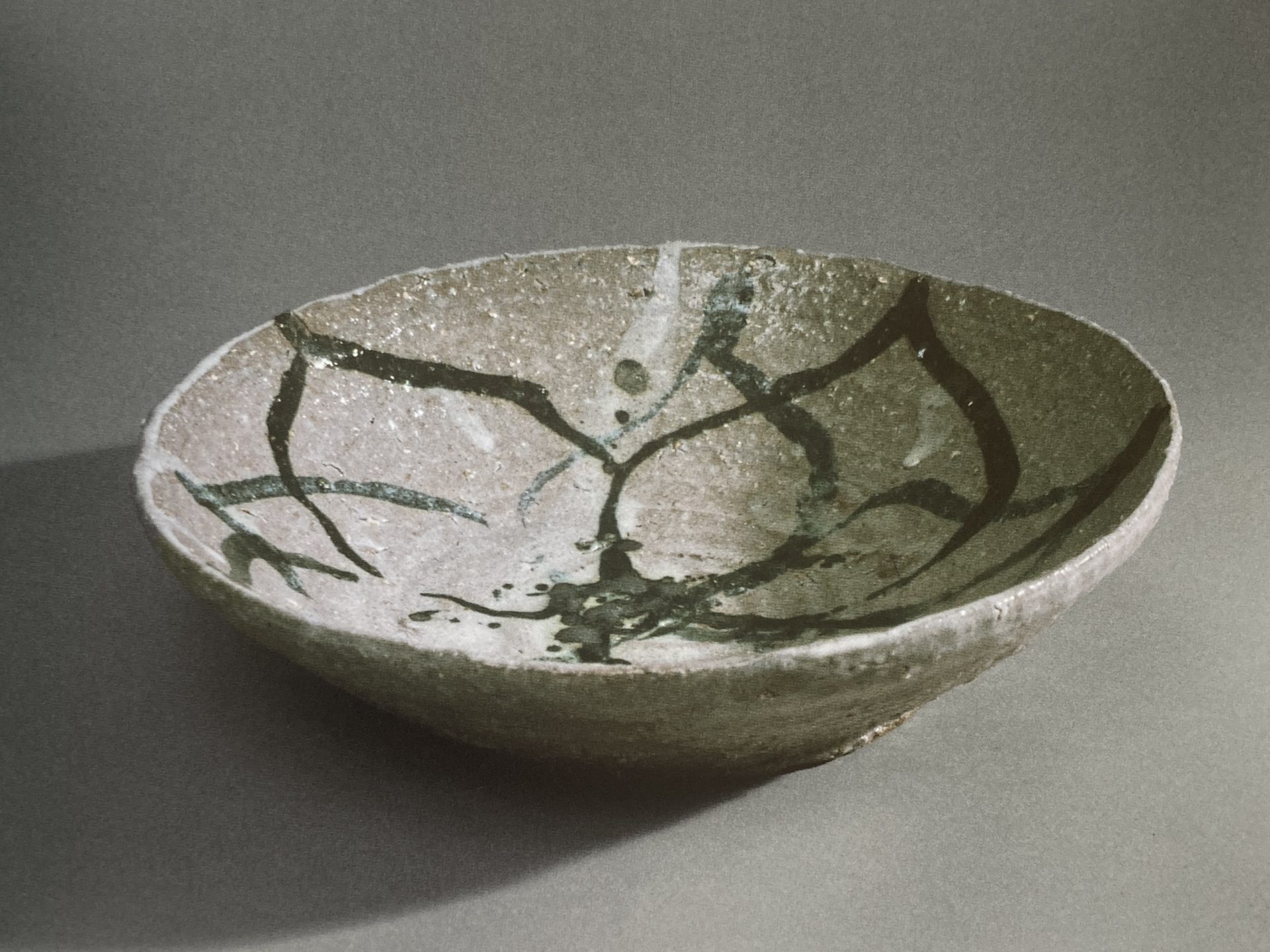
Wide bowl with flower drawing
φ: 10″
H: 2 1/2″
Garden clay, grapevine ash, feldspar, quarry mud
The soil in my garden can be used as clay. The stratum around here is a middle-generation basalt, and unlike the sedimentary soils of other pottery producing areas in Japan it has not experienced direct flooding. Therefore, I thought it would be better to crush and knead it rather than dissolve it in water and strain it.
Fortunately, I found a black soil that could be dissolved without any additives at a quarry in my prefecture. I used it as a pigment.
This method of material selection is similar to making single-origin coffee.

Plate with spiral detail
φ: 10 1/4″
Porcelain
We are supposed to avoid leaving hand marks on the clay when wheel throwing pottery-but the porcelain clay of Tobe is opaque enough to be considered stoneware, which is why I dared to let the marks remain.

Irregular bowl with white glaze and brown strips on opposite sides
φ: 7 1/2″/6 5/8″
H: 3 1/2″
Clay from Kagawa prefecture, feldspar, grapevine ash, easy-to-melt soil from Toon city
There is no such thing as failure in my pottery. Even if cracks form when a piece dries, I fill them with easy-to-melt clay before firing. I found this red clay by the river in my neighborhood, and it has come in handy. It is a basaltic material with high iron content.
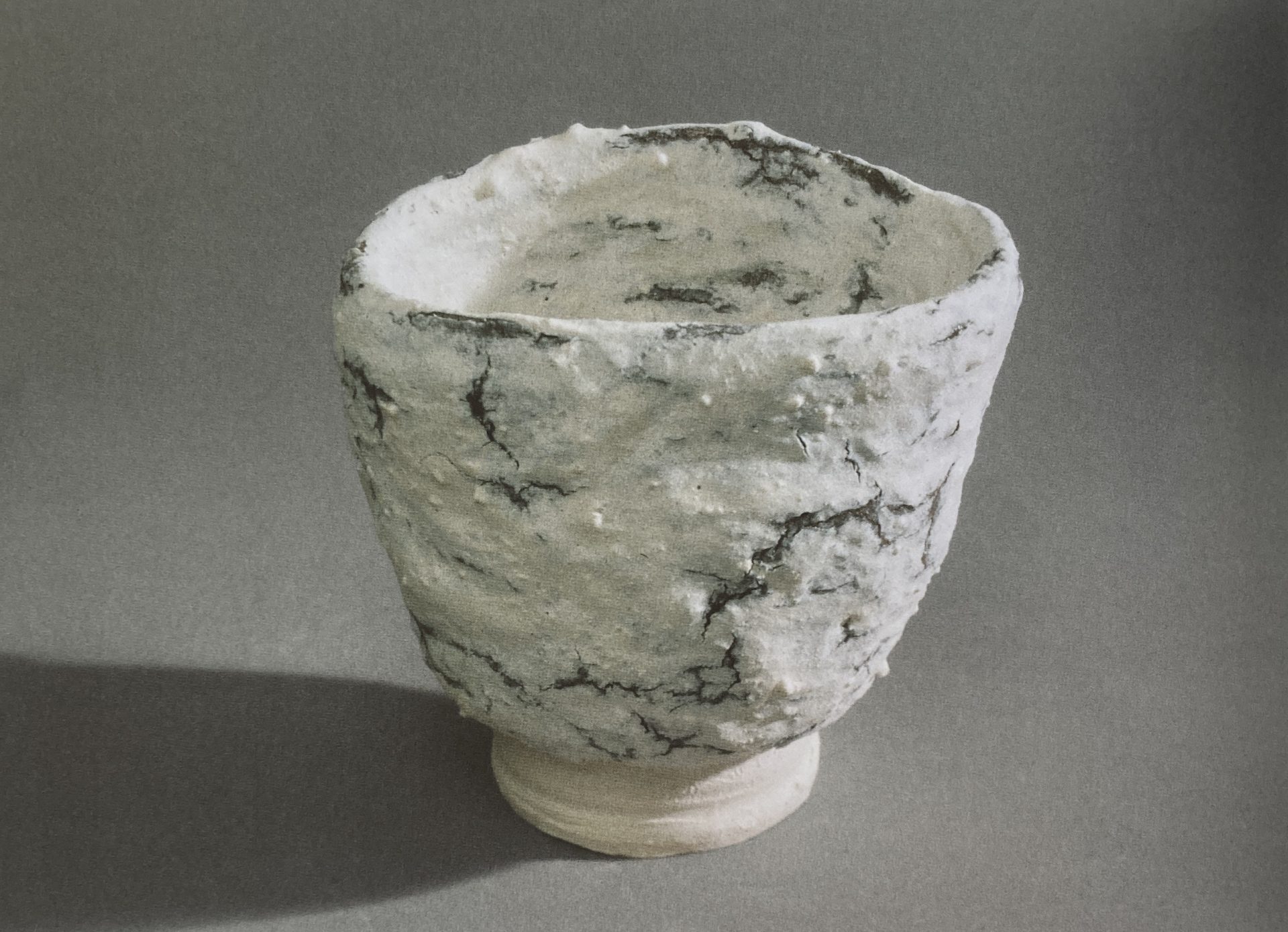
Irregular bowl with matte white glaze, from the series la tombe blanche (“grave painted in white”)
φ: 5″ / 3 3/4″
H: 4 1/2″
Easy-to-melt soil, porcelain
In 2018, I had an exhibition called “People Who Are Left Alive Yet.” I used various living figures as models for my vessels, including the Emperor of Japan, Prime Minister Abe, President Trump, and President Putin. This is the vessel I modeled after Prime Minister Abe. I used clay that melts easily in the kiln and decorated its surface with white porcelain clay, because I wanted to create an object that looks like porcelain but leans after being fired.

Black bowl, rough texture
φ: 7 1/8″
H:3 7/8″
Garden clay, quarry mud
This soil I found in a quarry develops a black color when oxidized or reduced. In reduction it turns a cold black, similar to that of the famous Raku ware called Mu ichi butsu (“Having Nothing”).

Bowl colored with yellow underglaze and brown details
φ: 6″
H: 2 3/4″
Porcelain, quarry mud, yellow under paint
Lucie Rie used uranium to produce her yellows. This is not uranium, but an unsuccessful attempt to produce a similar yellow, which I perfected by staining the paint with mud.

Plate with octopus and mountain
φ: 8″
Porcelain, quarry mud, cobalt
In the early days of Tobe ware, Arita potters had been abducted to Mitsuhama port in Matsuyama were forced to paint in the Old Imari style. This shows Gogoshima, located off the coast of the and uses a design from early Tobe ware that traditionally depicts fish and rabbits below the island.
When this dish cracked I used paint to stop the leaking.

Bowl with brown and blue details
φ: 6″
H: 3″
Porcelain, quarry mud, cobalt
This is another example of repairing a crack and covering it with color.
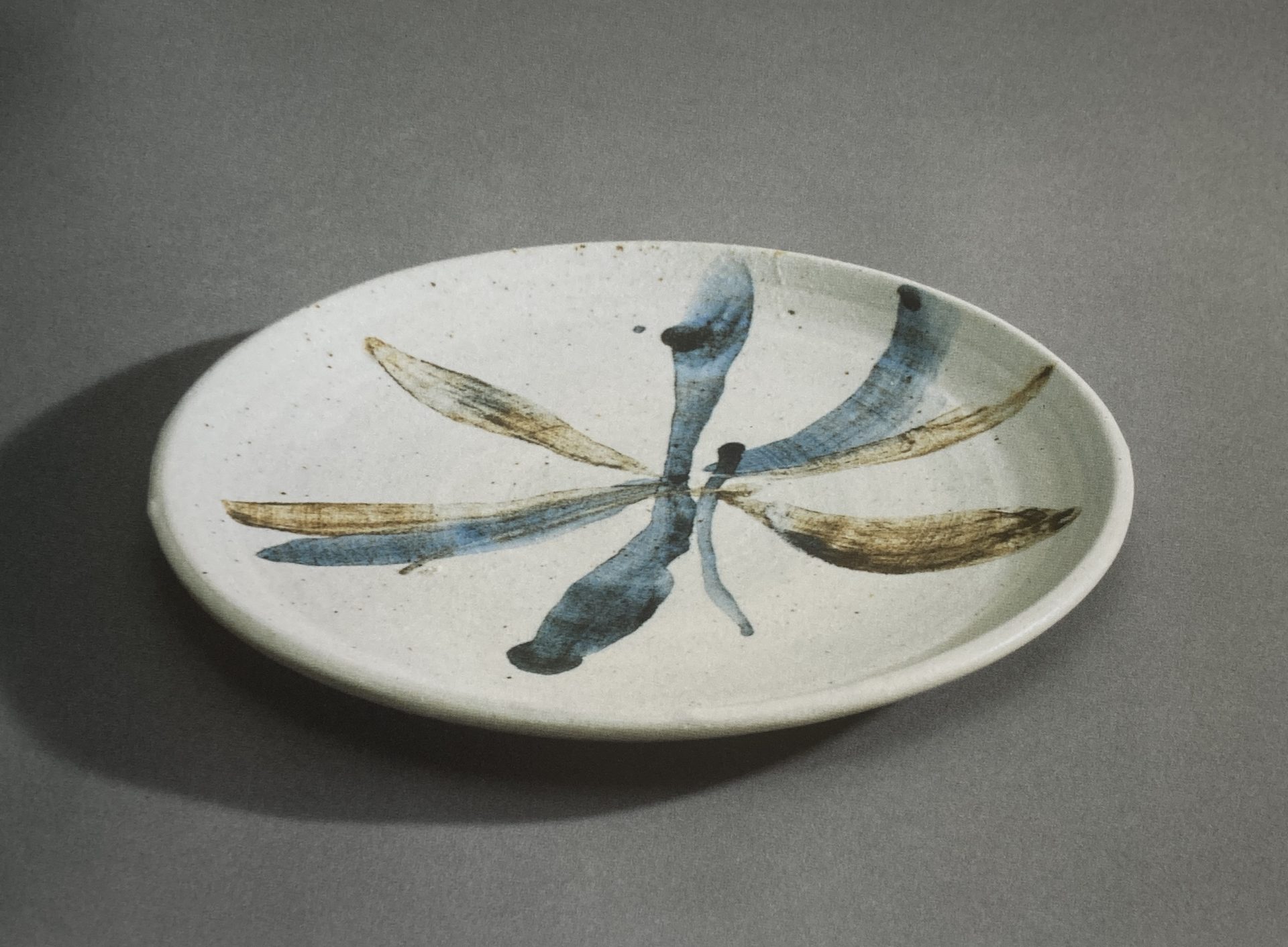
Plate with dragonfly wing drawing
φ: 8″
Porcelain, quarry mud, cobalt
In the fall, threadlike black and blueish silver dragonflies come to my house. In Vietnam, dragonflies are an important source of patterns.

Yellow bowl
φ: 8″
H: 3″
Porcelain, rice field mud from Teshima Island
Teshima Island in the Seto Inland Sea is a mecca for conspiracy theories. I stayed there and made an exhibition of fired clay collected from various parts of the island. This mud from the island’s rice paddies becomes a very soluble and fluid yellow glaze when fired.

Coil bowl with four legs
φ: 4 3/4″
H:4 1/4″
Clay from Toon city, feldspar, grapevine ash
Most of the old bronzes in China have four legs; in Japanese ceramics these legs are called cross-foot trimmings. Originally, only feudal lords were allowed to have bowls with a single, completely round foot, so potters deliberately cut one or several slits in the foot to enable common people to use them.

Plate with black details on rim
φ: 8 1/4″
H: 2″
Porcelain, pebbles
This is non-glazed Tobe ware porcelain and the rim is decorated with pebbles collected from nearby Go- shikihama (the “five-colored beach”). The melting stones are micas.

Plate colored with brown glaze, rough texture
φ: 7″
Porcelain, quarry mud
This was originally intended to be a white plate, but it was fired with quarry mud to cover up some kind of mistake.

Coil bowl with Oni Hagi glaze
φ: 5″
H: 3 1/2″
Clay from Toon city, rice chaff, feldspar, ash
This is in the style of Oni Hagi, but with a circle foot instead of the usual cross foot. Oni Hagi glaze is made from smoked rice husks. It is transparent but full of air bubbles that refract light, making it appear white.

Yellow bowl
φ: 6 7/8″
H: 2 1/2″
Porcelain, rice field mud from Teshima island

Bowl with brown outer band
φ: 6 1/2“
H: 3 3/8“
Porcelain
This is a bowl for eating Udon noodles.

left
Mug with striped handle
φ: 3 3/4″
H: 2 3/4″
right
Small bowl
φ: 3 3/4″
H: 2 7/8″
Porcelain
This is the only form I inherited from my father, and there are other forms just like it from the Yi dynasty.
Making work in this format is just like working with a bassline by Suicide or Les Rallizes Dénudés

left
Mug colored with dark glaze, matte finish
φ:3 3/4″ 3 3/8″
H: 3 1/8″
Porcelain
When I work in the Mingei way, sometimes I end up with something like this.
right
Mug colored with purple and dark glaze
φ: 3 1/4″
H: 3 1/2″
Porcelain

left
Mug with colored handle
φ: 3 1/4″
H: 2 3/4″
Porcelain
I aimed for the handle to be higher than the mouth of the drink, making it look like a squirrel’s tail.
right
Mug with cobalt and copper underglaze details
φ: 3 3/8″
H: 2 7/8″
Porcelain
This handle was made using a plaster mold. In order to show this, the excess soil from the mold has been
left intact without being scraped off.

left
Mug with brown glaze details
φ: 3 1/2″
H: 3 1/2″
Porcelain
right
Mug with brown and color glaze details
φ: 3 13/16″
H: 3 3/4″
Porcelain
This was an attempt to create a tintype mug shape, often seen in salt glaze.
